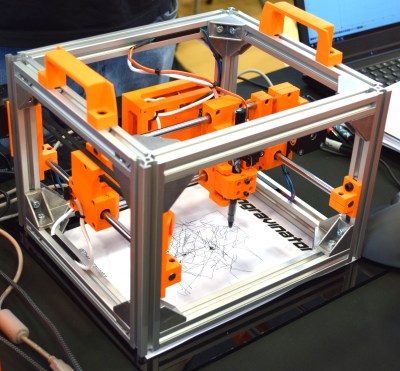Right now, you can get a diode laser engraver on eBay for around $100 USD. That sounds like a deal, but it’ll probably use some arcane proprietary software, won’t be terribly accurate, and the laser itself will almost certainly be fully exposed. Of course there’s no shortage of DIY builds which improve upon this situation greatly, but unfortunately the documentation and instructions to replicate them yourself often leave a lot to be desired.
To get a safe and accurate laser platform into the hands of hackers everywhere, we need more well documented open source designs that are actually built with community in mind. Projects like the Engravinator from [Adam Haile]. This isn’t a one-off design with documentation thrown together after the fact, it’s a fully open hardware engraver with a concise assembly guide that’s built from 3D printed parts and readily available components. You’re free to source and print the parts yourself or, eventually, purchase everything as a kit.
The microwave-sized Engravinator is built from standard 2020 aluminum extrusion, and offers a workable area of 130mm x 130mm. There’s a hatch on the front of the enclosure for objects that are small enough to fit inside the machine, but the open bottom and handles on the top also allow the user to place the Engravinator directly onto the work surface. [Adam] says this feature can be especially useful if you’re looking to burn a design into a tabletop or other large object.
Outside of the aluminum extrusion and miscellaneous hardware that make up the frame, most of the other parts are 3D printed. Released under the CERN Open Hardware License v1.2 and distributed as both STL and STEP files, the printable parts for the Engravinator are ripe for modification should you be so inclined. The same goes for the DXF files for the enclosure panels, which will need to be cut out of orange acrylic with a CNC or (ironically) a laser.
Movement is provided by two NEMA 17 steppers and a GT2 belt arrangement, and [Adam] has even put together a custom control board he calls the Platypus using TMC2100 drivers; though you could always swap that out for a basic RAMPS board if you’re going down the DIY route. You can use any PWM-controlled diode laser with the common 16x40mm M3 bolt pattern, of which there’s no shortage of options on eBay.
[Adam] estimates the total cost of an Engravinator, assuming you start from absolutely nothing, is between $300 and $400 USD. But naturally that price will vary significantly on how much of the hardware you can find by rummaging through your parts bins or even by salvaging from something else. If you’ve got an outdated 3D printer collecting dust, you could pull a good deal of the hardware required from there.
We had a chance to see the Engravinator in action at the recent 2019 East Coast RepRap Festival, and definitely came away impressed. It’s a solid machine and the results on display all looked incredibly crisp. …read more
Source:: Hackaday

